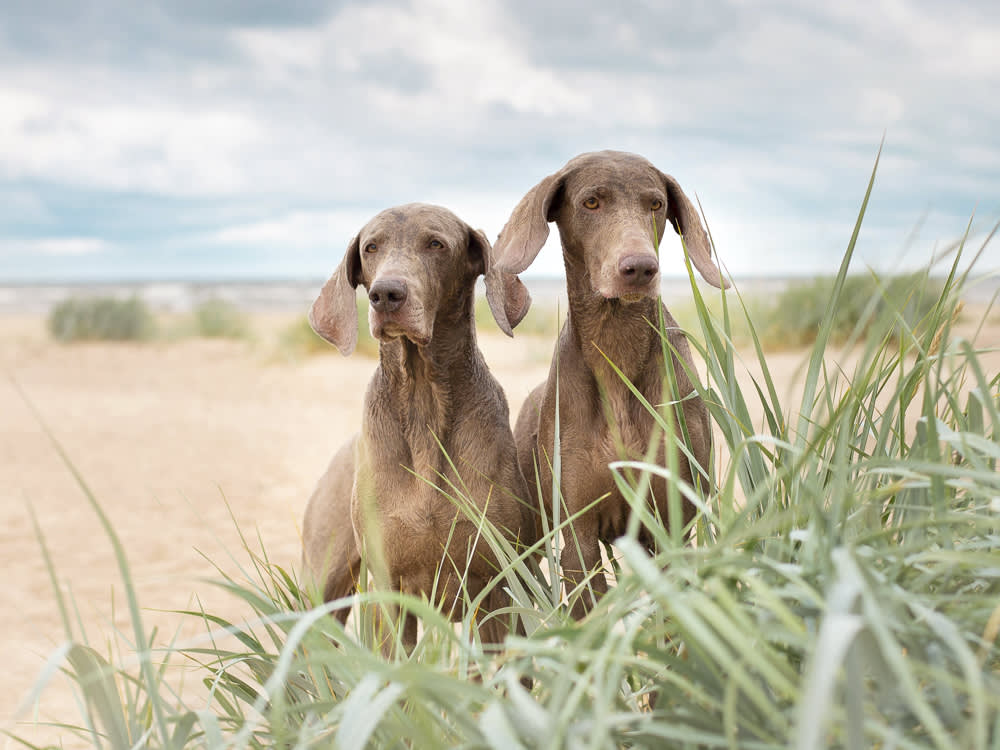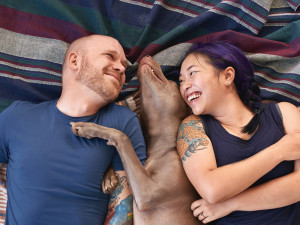Male vs. Female Dogs: Are There Any Real Differences?
World-renowned behaviorist Patricia McConnell explains.

share article
Is there really a difference between male and female dogs? “If you want a good dog, get a male. If you want a great dog, get a female — and cross your fingers.” That old saying has been passed down through generations in a variety of fields from Retriever training to Sheepdog handling. But is it true? Are there significant sex-related differences in the training and performance of dogs?
Male vs. female dogs: Are there any real differences?
The most important factor is the individual dog’s personality. It’s true that male dogs are typically larger and have larger heads and necks than female dogs — statistically, they are taller and weigh more.
Some studies have shown that male dogs are more aggressive than female dogs, while other studies have found no significant differences. Spaying and neutering can serve to reduce some of the behavioral differences between male and female dogs. It’s important to socialize and train all dogs, regardless of their sex.
The research on male vs. female dogs
The first obvious source for an answer is the annals of research. The problem is, it’s only recently that dogs have migrated from persona-non-grata status in science to an animal of interest. Research on domestic dog behavior is blossoming, but most of it is about cognition and problem solving. That’s great stuff, but it won’t necessarily answer our question.
The classic Genetics and the Social Behavior of the Dogopens in a new tab by Scott and Fuller, first published in 1965 asks: “Are male dogs bigger than females?” They found sex differences in weight gain (male dogs, not surprisingly, grow larger in early adolescence), but concentrated primarily on breed differences, rarely looking at sex as a factor in any of their experiments. They did ask if sex had an influence on what they called “emotional reactivity.” Based on their scoring system, female dogs averaged 5.0 and male dogs 4.9 — in other words, no difference at all.
Are there behavioral differences between male and female dogs?
Aggressiveness and boldness, described as a behavioral syndrome, were reported as being higher in males than females. Females also seemed more inclined to interspecific social interactions with humans in tasks that require cooperative skills, but males appeared more inclined to social play, thus implying different levels of social engagement between the sexes, depending on the context.
Studies on cognitive processes underlined a greater flexibility in resorting to a particular navigation strategy in males. Both male and female dogs have the ability to show aggression, but the statistics show that “entire” (not neutered) male dogs are more likely to show aggression than female dogs or neutered males. Unfortunately this isn’t the easy answer it might appear to be.
Male dogs are likely to be more competitive over things they value than are either females or neutered males. They may be more confident in their ability to control things they think are important and that may lead them into conflict in situations in which their owners expect them to defer, or do as they are told.
Are male or female dogs more affectionate?
A University of California Davis School of Veterinary Medicine studyopens in a new tab revealed that hormone levels of oxytocin (the “cuddle” hormoneopens in a new tab) and vasopressin (an antidiuretic hormone linked to heightened aggression in humans) influence canine social behavior and aggression, too. Interestingly, service dogs, which are bred for their easy-going temperament had higher levels of oxytocin in their blood compared to average dogs.
In contrast, dogs who were more aggressive toward other dogs had more vasopressin. What isn’t known is if vasopressin levels cause aggression or are the result of aggression, but at least there is an underlying base for the behavior for more research to be done. So maybe some behavior traits aren’t a matter of gender but of other factors like hormones and as canine behavior experts say, individual temperament, genetics, breeding, socialization, environment, and leadership of pet parents.
Are there learning differences between male and female dogs?
Here are some answers from fellow trainers:
“Male dogs are softer.”
“Female dogs are softer.”
“Male dogs are more independent.”
“Female dogs are more independent.”
“Male dogs are easier to train than female dogs.”
“Female dogs are easier to train than male dogs.”
Despite these contradictions, there are some interesting trends. First of all, a great many of the respondents said that, in training and performance, the personality and background of any individual dog were more important factors than sex.
Do male dogs require more training?
At this time there is no scientific research stating that female dogs are easier to train than male dogs. So, at times that may make a male dog easier to train than a female dog. If a dog is not spayed or neutered they will be more easily distracted by their environment due to natural dog behavior that comes along with being intact. An unneutered male will likely be more difficult to train. Some characteristics that make a dog harder or easier to train is their breed, their age, and genetics.
Other consistencies in the responses lead to compelling questions in their own right. Many of the answers expressed the belief that male dogs mature more slowly than female dogs, describing young male dogs as “goofy,” “slow to mature,” and “less focused than female dogs” in their adolescenceopens in a new tab. This is an especially interesting observation given that in our own species, girls are known to mature faster than boys.
Another contrast drawn between male and female dogs was that male dogs perform better in certain types of competition. From herding to Schutzhund to retrieving, whether we like it or not, they dominate the winner’s box. Based on their names, 12 of 15 winners of the last 15 years of International Sheepdog Trials were male and two were female (one could have been either). Since 1990, 19 dogs have won the U.S. National Open Retriever Championships. Sixteen were male dogs, two were female dogs, and one is still “unknown” (to me, that is; I’m sure someone knows!). This trend is replicable in many of the highly competitive performance sports, especially those that involve large sums of money.
Does it matter if the dogs are neutered?
It's challenging to tease out why male dogs perform better in competition. One logical explanation has nothing to do with the ability or competitiveness of either sex. Dog-related sports, like herding and retrieving, involve a lot of money, and in almost all of them, intact, potentially breeding male dogs and female dogs compete, never neutered or spayedopens in a new tab animals. (This raises a complication not addressed in the original question — when we say male dogs, are we talking intact breeding males, or neutered male dogs? Given that there is so little real data on the question of sex, we’ll have to leave this aspect aside for now, but it is important to acknowledge that intact versus neutered could be an important factor.)
If you are running intact animals, as almost all high-powered handlers do in competition, the sex clearly has an effect on which sex you’re going to invest in. You can’t run a female dog when she’s in heat, and neither is it wise, or ethical for that matter, to run a female dog when she’s in the latter stages of pregnancy or nursing a litter. Who wants to invest large amounts of time and money in a performer who can do her job only half the time?
In addition, many competitors breed and train their dogs for a living. Say you own more than one top-notch performer. You will surely ask yourself which animal could best support your kennel and buy the dog food — a male dog who can be bred several times a week for a hefty stud fee? Or a female dog who might produce one (regrettably, sometimes two) litters of puppies a year?
Another explanation is that there is indeed something about a male dog that makes him more competitive under pressure. Testosterone is a powerful drug, and we know it has broad-ranging effects on assertive and aggressive behavior in species as different as rhesus macaque monkeys and mallard ducks (not to mention traders on the stock market, who are more successful if they have longer ring fingers than middle fingers — which is believed to correlate with the production of male hormones in utero. No kidding.)
How human perception plays a role
There’s another possible influence on the behavior of male and female dogs, but this time it relates to our behavior. How much of our demeanor around dogs is based on our expectations of “maleness” and “femaleness”? But are these expectations based solely on culture? Or is some of a dog’s personality determined by their sex, as with the obvious sex-related behaviors like scent marking, roaming, and interspecies conflict?
The bottom line: More research is needed
Here’s what we do know: This is a topic that calls for research. Dogs are finally coming out of the woodwork as interesting and important in our search to understand the biology of behavior, and this is a perfect vehicle for study. What’s shocking is that we know so little about canine behavior, and what’s exciting is that there is so much to learn.
For example, Dr. Anneke Lisberg just completed her PhD from the University of Wisconsin on scent-marking behavior in dogs, a topic we know shockingly little about. Dr. Camille Ward completed her University of Michigan dissertation on social development and play behavior in puppies. These are but two examples of the kind of rigorous science-based studies that dogs deserve. But we need more, lots more, and I hope the trend of investing time and resources into the study of canine behavior continues to gather steam.
FAQs (People also ask):
Do male or female dogs have more health problems?
Technically, there isn’t a healthier sex. Health problems typically, but not always, depend on breeding and genetics. At times, due to the larger size of male dogs, they may suffer more from joint issues.
Are male dogs more dominant?
Both male and female dogs can show traits of dominance. I have found that it will really depend on the dog. Non-neutered males are typically more dominant than the latter. But some female dogs can show dominant personality traits.
Do female dog heat cycles cause behavioral issues?
Female dogs often show certain behaviors while going through a cycle. They may show higher levels of aggression during a cycle. At times, spaying a dog can help decrease aggression because it can lower that behavior.
Do male dogs mark territory indoors?
Male does are more likely to mark territory indoors especially if they are not neutered. Female dogs may also mark indoors if they are not spayed. Male or female dogs may mark indoors if another dog has marked or urinated in the spot and it was not properly cleaned.

Patricia McConnell, PhD
Patricia McConnell, PhD, is an animal behaviorist and ethologist and an adjunct associate professor in zoology at the University of Wisconsin, Madison, as well as the author of numerous books on behavior and training.

Danielle Vrabel, CPDT-KA
Danielle Vrabel is a dog trainer who earned her CPDT-KA in 2020. Danielle is a proud pet mom of five pets: two dogs, two cats, and a corn snake. Danielle has fostered over 10 dogs and 15 cats/kittens as well as helped train shelter dogs before they are adopted. Both of Danielle’s dogs are pet therapy dogs, where she also volunteers her time helping evaluate future therapy dogs.
Related articles
![A dog reaching up to grab a blue ball out of a woman's hand.]() opens in a new tab
opens in a new tabPlaying With Dogs Improves Their Training Success
Post-training play may extend a dog’s memory of previously learned behaviors by up to a year.
![Russian Toy Terrier with ears back]() opens in a new tab
opens in a new tab9 Reasons Why Dogs Put Their Ears Back
Here’s how your dog’s ears can clue you in to how they’re feeling.
![dog trainer robert haussman, aka dogboy, shares his favorite dog training tools and toys]() opens in a new tab
opens in a new tabDog Trainer Robert Haussmann’s Favorite Enrichment Toys
The Wildest Collective expert shares his top toys and tools, from classics Kongs to snuffle mats to slow feeders.
![Happy pet owners cuddling with their dog]() opens in a new tab
opens in a new tabHow to Spark Joy in Your Dog’s Life
(And your own, while you’re at it.)





